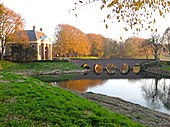Koepoort
| Koepoort | |
|---|---|
 The Koepoort seen from the city's side (eastern) | |
 | |
| General information | |
| Type | City gate |
| Location | Enkhuizen, Netherlands |
| Completed | 1649 |
| Inaugurated | 1654 |
The Koepoort or Westerpoort is a city gate in Enkhuizen. The gate used to be the main western entrance of Enkhuizen and is a part of the old fortifications of the city.
Description
Between 1590 and 1593 Enkhuizen was extended toward the west. A new city wall was built with a moat and seven bastions. At the Koepoort's current location, a wooden gate and a drawbridge were built. Fifty years later plans for a stone gate spread. The Koepoort's architect is probably Jacob van Campen. In 1649 the foundation stone was put at its place, but it soon turned out that the Bentheimer sandstone used in the design coundn't be supplied. The gate was finished provisionally in 1654. Traffic was guided through the gate. Because of a paved road towards Hoorn, that was made in 1672, a big chunk of all the city's traffic came in through the gate. The Koepoort soon began to decay because of lacking maintenance. In 1730 the gate was recovered and provided with a cupola. In 1793 a clockwork was placed inside the cupola.
Since 1930, the traffic is guided around the gate. The main street of Enkhuizen, the Westerstraat, ends at the Koepoort and continues as Westeinde. In 1987 a statue of the so called "Stedemaagd" was placed at the city side of the gate. The statue was made by Han Sterk.
-
Koepoort seen from the outer side (western side)
-
The "Stedemaagd" of Enkhuizen at the Koepoort
-
Koepoort seen from the Northern side



